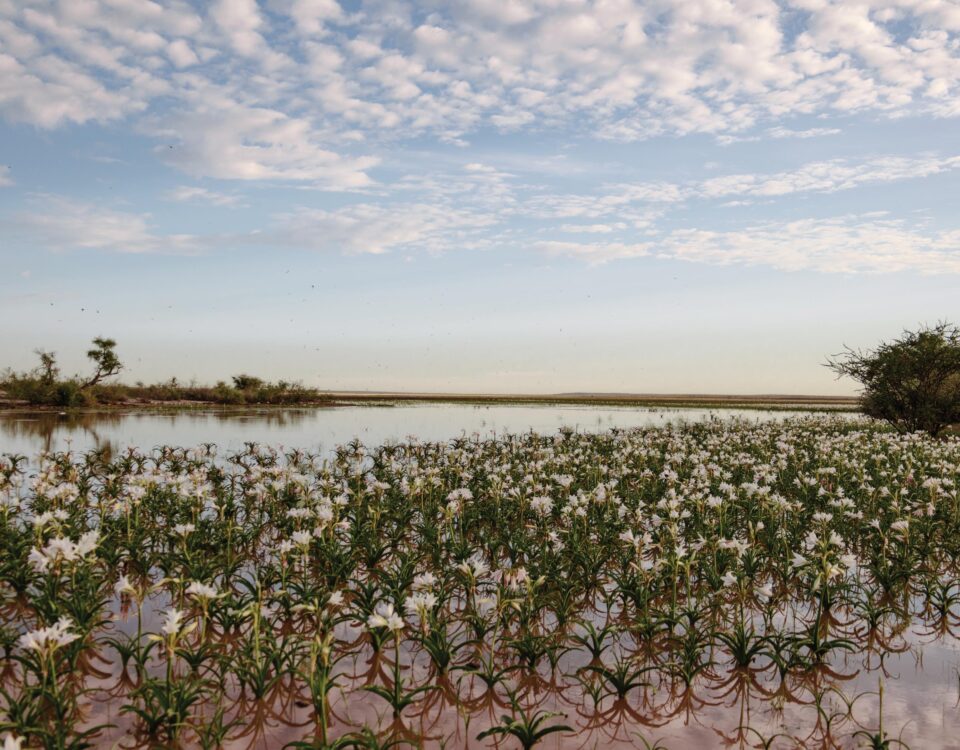Namibia: Haute Cuisine in the deepest Bush
September 3, 2012Swakopmund: The Hansa celebrates its first 100 years
September 3, 2012by Amy Schoeman
The ‘anti-plant’ that thrives under drought conditions
The osonanga lily (slangkop, groenlelie, Pseudogaltonia clavata, Lidneria clavata) , is described by botanists as a ‘relatively unimportant poisonous’ plant. Moreover, it grows commonly in the western Kalahari Desert, South Africa’s far northern Cape and most parts of Namibia.
Yet it intrigued Carl Hilker so much that he commissioned Cape Town botanical artist Elbe Joubert to produce this fine watercolour of the plant. He then bought the original, had it professionally reproduced in the United States and brought back 25 large (A2) and 250 smaller (A3) prints to Namibia, which are now being sold to raise funds for the Cheetah Conservation Fund (CCF).
Carl says the unimportant poisonous lily intrigues him so much because it’s actually an ‘anti-plant’.
“All the good things in life that other plants flourish on, such as abundant rains and nutritious soil, the osonanga lily scorns. It grows at its best in rough, poor sandstone soil and only really flourishes in times of severe drought. It won’t grow when there’s grass around, only on open land where the other plants have withered and died. In other words, it loves what other plants hate.”
Carl, who has been coming to Namibia from the USA two or three times a year since 1994, says he’s never seen the lily looking as good as it did at the height of the drought in the mid-nineties.
According to the books, the osonanga lily is a perennial bulbous plant, creamy brown in colour, with greyish green leaves that are generally produced together with or after the tubular flowers. These are borne at the top of the tall slender stem and are white with light-green longitudinal bands. Flowering time is in late spring and early summer, and the plant is especially abundant in sandy to clay soils near dry river courses and pans.
The osonanga is one of the so-called slangkop plants and is toxic to livestock. Being bulbous, the lilies are less dependent on rainfall than most other plants in the veld, drawing on their reserves to sprout early in spring before the rains. In drought years these plants are often the only greenery around for stock to eat during the critical months of September to November.
![Pseudogaltonia clavata flowering after rain in the Kgalagadi Transfrontier Park, Northern Cape, South Africa. [photo Colin Paterson-Jones ©]](https://www.travelnewsnamibia.com/wp-content/uploads/Pseudogaltonia-clavata-flowering-after-rain-in-the-Kgalagadi-Transfrontier-Park-Northern-Cape-South-Africa.-photo-Colin-Paterson-Jones-©-198x300.jpg)
Pseudogaltonia clavata flowering after rain in the Kgalagadi Transfrontier Park, Northern Cape, South Africa. [photo Colin Paterson-Jones ©]
The inflorescence and palatable young leaves are the most toxic. Fortunately most animals avoid the osonanga because of its vile taste, although Carl has observed gemsbok digging up the onion-shaped root to get at the moisture.
Botanical artist Elbe Joubert has been painting life-size botanical watercolours primarily from live specimens since 1990. Besides the Liliaceae family, she’s been commissioned to paint succulents, Cape fynbos and the marine flora of South Africa, winning gold medals at the Royal Horticultural Show in London and the Biennale exhibition in Cape Town’s Kirstenbosch.
Additional Information from http://www.pacificbulbsociety.org/pbswiki/index.php/Pseudogaltonia:
Pseudogaltonia (osonanga lily) clavata is from the summer rainfall region of Namibia. It produces huge bulbs that look like coconuts. Flowers are white and funnel-shaped. According to Harry Hay who grows this in England, his plants took 21 years from seed before they flowered. Seeds can be treated like any other flat-seeded amaryllids. They germinate easily with warm temperatures. Plants should be grown warm when possible.
| Synonyms: |
Galtonia clavata, Maxwell Tylden Masters 1884. Lindneria clavata, Franz Speta 1985.Lindneria fibrillosa T.Durand & Lubbers. Pseudogaltonia pechuelii Engl. Pseudogaltonia subspicata Baker. Hyacinthus pechuelii Kuntze. http://www.bihrmann.com/caudiciforms/subs/pse-cla-sub.asp |
This article appeared in the July/Aug ‘05 edition of Travel News Namibia.
Additional photographic sources:
http://sophy.u-3mrs.fr/Afriqsud/Photo-cpAFS/P/Pseudogaltonia_clavata______15_10_2003_4.JPG
http://www.bihrmann.com/caudiciforms/subs/pse-cla-sub.asp
http://www.bihrmann.com/caudiciforms/subs/pse-cla-sub.asp

![Pseudogaltonia clavata flowering near Tsumeb, Namibia. [photo Colin Paterson-Jones ©]](https://www.travelnewsnamibia.com/wp-content/uploads/Pseudogaltonia-clavata-flowering-near-Tsumeb-Namibia.-photo-Colin-Paterson-Jones-©-198x300.jpg)

1 Comment
this plant is extraordinary, but my curious comes in the propagation and seed storage